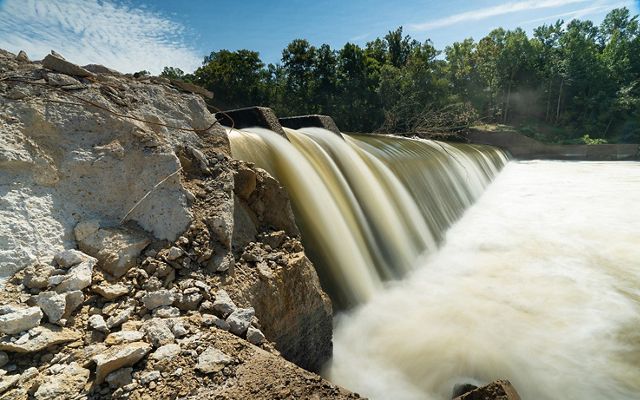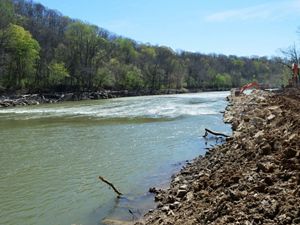Helping Rivers Flow: Sustainable Rivers Program Celebrates 20 Years
The innovative program began in Kentucky on the Green River.
By Phillip Lopez
Flowing 384 miles through central Kentucky, the Green River is rich with biodiversity, containing roughly 70 mussel species and up to 150 fish species, many of which are found here and nowhere else.
“It was definitely among the most biologically significant river systems in the nation, and the U.S. Fish and Wildlife Service recognized it as the most biologically rich branch of the Ohio River system,” said Dr. Richard Kessler, who served as the Green River project director for TNC when the idea for the Sustainable Rivers Program, or SRP, began to surface in the late 1990s.
During this time, Kessler and other aquatic biologists were increasingly alarmed by declining populations of rare mussels, fish and invertebrates in the river. Kessler grew up 25 miles downstream from the Green River Lake Dam.

A River in Need
“My entire life, I grew up on a river that I knew was changed because of the presence and management of the dam,” he said.
Most of the nation’s water infrastructure was built before much consideration was given to their ecological impacts. “Today, we better understand how dams impact natural river flows,” Kessler added.
Kessler and other TNC scientists were faced with the challenge of identifying ways to protect and restore the Green River’s biodiversity, and science led them to the flows, which, in turn, would also improve water quality in the river.
“It was our job to think through the bio-hydrology, which meant determining how altered flows from the dam affected things like growth patterns and the timing or even loss of reproduction for downstream mussels and fish,” Kessler said.
Support Kentucky's Conservation Work
Donate NowGiving Mussels a Chance
Before flows were improved through the SRP, all the outflow from Green River Lake was released from the bottom of its dam, meaning the water was typically much colder than historical flows. Kessler and his colleagues identified that these colder flows were likely disrupting native mussels downstream that spawn in the fall and winter—the same time the Corps would reduce the lake’s level to prepare for potential spring floods.
The scientists discovered, however, the temperature of the outflow from the dam could be raised by using multiple outlets. Additionally, postponing the annual drawdown would give mussels a better chance to reproduce, and it could also improve fishing conditions in Green River Lake by keeping water levels higher longer, which later proved to be popular among anglers.

Partnering for Conservation
In 1998, Kessler, along with other TNC hydrologists met with environmental scientists at the Corps of Engineers’ Louisville District—which was responsible for the operation of the Green River Lake Dam—to discuss the river’s ecological challenges and potential solutions. Working together, the scientists developed recommendations that would allow for the restoration of a more natural flow regime while still maintaining other mission requirements for the reservoir and dam.
“The Corps was very receptive and appreciated having an informed request,” Kessler said. “We at TNC, on the other hand, recognized the engineering challenges they faced in order to ensure the needs of local communities as well as state and federal partners were still met.”
Dr. John Hickey, a senior engineer who leads the SRP for the Corps, said, “This was the first collaboration of its kind between TNC and the Army Corps of Engineers, and it immediately started producing positive results.”
In fact, it didn’t take long before researchers began finding juvenile mussels downstream of the dam, and because some mussels can live 70-plus years, this was encouraging news.

Spreading the Word
TNC and Corps scientists from the Louisville District began sharing success stories from the Green River with Corps districts throughout the nation, several of which became interested in participating in the SRP.
"It was an exciting time. Corps water managers were dealing with different issues at each river—ranging from riparian habitat loss to disrupted fish migration and water quality issues—but all were related to flows. Engaging water managers, operators, planners, scientists and stakeholders in a science-based approach to consider flow management alternatives showed that there are opportunities to help the environment within the context of all operating purposes. An exciting aspect of the Green River reoperation was that it benefited the environment and also recreation and regional economic activity,” Hickey said.
By 2021, the SRP had grown from eight initial rivers in 2002 to 40 rivers that encompass nearly 11,000 miles of waterways and include 89 reservoirs. Today, science from these sites is proving that re-operating dams and modernizing other river infrastructure as part of whole-river systems increases the benefits they provide, particularly when done so in coordination with the downstream management of floodplains and other infrastructure.
Policymakers Lend a Hand
Jim Howe, who is a senior policy advisor for freshwater for TNC and the organization’s SRP lead, said, “members of Congress began to take notice of the program's success in their districts. They knew it was bringing together stakeholders from navigation, municipal water supply, anglers and boaters to find collaborative, viable and cost-effective solutions for updating operations of dams in ways that achieve environmental benefits without sacrificing other mission priorities.”
Because U.S. legislators recognized the value of the program’s many benefits—including its potential role in mitigating flood impacts—Congress significantly increased the nation’s annual investment in the program within the past few years.
“Additional funding led to more participating rivers, and it enabled the program to broaden the types of environmental actions to achieve the sustainable management of water and associated ecosystems,” Howe said. “For instance, the Corps is working to adapt SRP methods for other infrastructure, especially locks and dams on larger rivers where commercial barge traffic occurs.”
The true value of the SRP, Howe said, is its potential applicability to the more than 600 dams, 403 million acre-feet of water storage and 53,000 miles of rivers impacted by Corps dams.
Learn more about the SRP and other project success stories, visit www.nature.org/SRP.




